Which of the following will have weakest indicated C-H bond?



CH3−H
The correct Answer is:C
To determine which compound has the weakest indicated C-H bond, we need to analyze the influence of substituents on the stability of the resulting carbon ion formed when the C-H bond is broken. Here's a step-by-step breakdown of the solution:
Step 1: Identify the Compounds
We need to look at the given compounds and identify the indicated C-H bond in each.
Step 2: Break the C-H Bond
When we break the C-H bond in each compound, we will form a carbon ion (negatively charged carbon). For example, if we take compound A, breaking the C-H bond will yield a carbon ion with a negative charge.
Step 3: Analyze the Effect of Substituents
- Compound A: The carbon ion formed will have a nitro group (NO2) attached. The nitro group is an electron-withdrawing group, which stabilizes the negative charge on the carbon ion. This stabilization makes it easier to break the C-H bond.
- Compound B: This compound has multiple alkyl groups (CH3). Alkyl groups are electron-donating groups, which destabilize the negative charge on the carbon ion. Therefore, the C-H bond in this compound is stronger and less likely to break.
- Compound C: Similar to compound B, this compound also has multiple alkyl groups that destabilize the carbon ion, making the C-H bond stronger.
- Compound D: This compound has no stabilizing groups, and the carbon ion formed will be unstable due to the lack of resonance or electron-withdrawing effects.
Step 4: Compare the Stability of Carbon Ions
The stability of the carbon ions formed from each compound is crucial:
- The carbon ion from Compound A is stabilized by the electron-withdrawing nitro group.
- The carbon ions from Compounds B, C, and D are destabilized by electron-donating groups or lack of stabilizing factors.
Step 5: Determine the Weakest C-H Bond
Since the C-H bond in Compound A can be broken more easily due to the stabilization of the resulting carbon ion, it has the weakest indicated C-H bond among the compounds.
Conclusion
The compound with the weakest indicated C-H bond is Compound A due to the presence of the electron-withdrawing nitro group, which stabilizes the negative charge on the carbon ion formed upon breaking the bond.
---
We need to look at the given compounds and identify the indicated C-H bond in each.
When we break the C-H bond in each compound, we will form a carbon ion (negatively charged carbon). For example, if we take compound A, breaking the C-H bond will yield a carbon ion with a negative charge.
- Compound A: The carbon ion formed will have a nitro group (NO2) attached. The nitro group is an electron-withdrawing group, which stabilizes the negative charge on the carbon ion. This stabilization makes it easier to break the C-H bond.
- Compound B: This compound has multiple alkyl groups (CH3). Alkyl groups are electron-donating groups, which destabilize the negative charge on the carbon ion. Therefore, the C-H bond in this compound is stronger and less likely to break.
The stability of the carbon ions formed from each compound is crucial:
- The carbon ion from Compound A is stabilized by the electron-withdrawing nitro group.
- The carbon ions from Compounds B, C, and D are destabilized by electron-donating groups or lack of stabilizing factors.
Since the C-H bond in Compound A can be broken more easily due to the stabilization of the resulting carbon ion, it has the weakest indicated C-H bond among the compounds.
The compound with the weakest indicated C-H bond is Compound A due to the presence of the electron-withdrawing nitro group, which stabilizes the negative charge on the carbon ion formed upon breaking the bond.
Topper's Solved these Questions
- ORGANIC CHEMISTRY: SOME BASIC PRINCIPLE AND TECHNIQUESBOOK - AAKASH INSTITUTE ENGLISHCHAPTER - ORGANIC CHEMISTRY: SOME BASIC PRINCIPLE AND TECHNIQUESEXERCISE - SECTION-C OBJECTIVE TYPE QUESTION (MORE THAN ONE OPTIONS ARE CORRECT)
18 Videos
- ORGANIC CHEMISTRY: SOME BASIC PRINCIPLE AND TECHNIQUESBOOK - AAKASH INSTITUTE ENGLISHCHAPTER - ORGANIC CHEMISTRY: SOME BASIC PRINCIPLE AND TECHNIQUESEXERCISE - SECTION-D LINKED COMPREHENSION TYPE QUESTIONS
7 Videos
- ORGANIC CHEMISTRY: SOME BASIC PRINCIPLE AND TECHNIQUESBOOK - AAKASH INSTITUTE ENGLISHCHAPTER - ORGANIC CHEMISTRY: SOME BASIC PRINCIPLE AND TECHNIQUESEXERCISE - ASSIGNMENT SECTION-A COMPETITION LEVEL QUESTIONS
50 Videos
- ORGANIC CHEMISTRY : SOME BASIC PRINCIPLES AND TECHNIQUES BOOK - AAKASH INSTITUTE ENGLISHCHAPTER - ORGANIC CHEMISTRY : SOME BASIC PRINCIPLES AND TECHNIQUES EXERCISE - Assignment(Section-D)(Assertion - Reason Type Questions)
15 Videos
- POLYMERSBOOK - AAKASH INSTITUTE ENGLISHCHAPTER - POLYMERSEXERCISE - ASSIGNMENT (SECTION-D)
13 Videos
Similar Questions
Knowledge Check
Which of the following is the weakest acid ?
ACl3CCOOHBCl2CHCOOHCClCH2COOHDCH3COOHWhich of the following is the weakest Bronsted base?
A B
B C
C D
D
Which of the following is the weakest base ?
View SolutionWhich of the following base is weakest ?
View SolutionWhich of the following is weakest acid?
View SolutionWhich of the following is the weakest Bronsted base?
View SolutionWhich of the following is the weakest Bronsted base?
View SolutionWhich of the following is weakest oxidising agent ?
View Solution